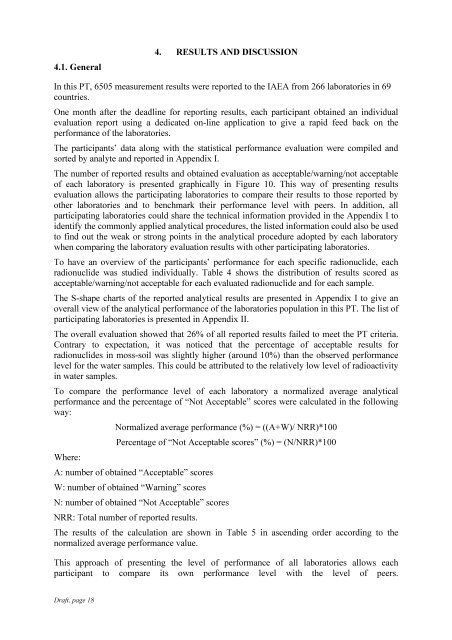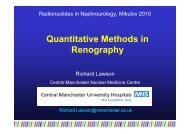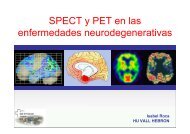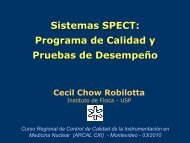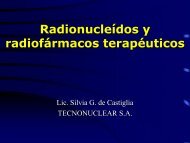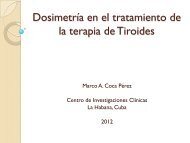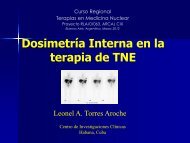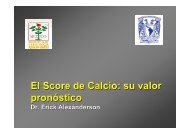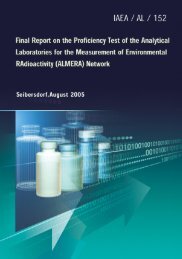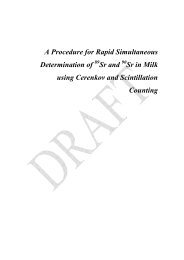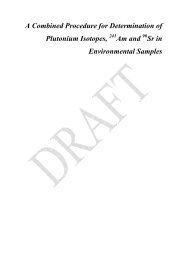Worldwide Open Proficiency Test: Determination of ... - Nucleus - IAEA
Worldwide Open Proficiency Test: Determination of ... - Nucleus - IAEA
Worldwide Open Proficiency Test: Determination of ... - Nucleus - IAEA
You also want an ePaper? Increase the reach of your titles
YUMPU automatically turns print PDFs into web optimized ePapers that Google loves.
4.1. General<br />
Draft, page 18<br />
4. RESULTS AND DISCUSSION<br />
In this PT, 6505 measurement results were reported to the <strong>IAEA</strong> from 266 laboratories in 69<br />
countries.<br />
One month after the deadline for reporting results, each participant obtained an individual<br />
evaluation report using a dedicated on-line application to give a rapid feed back on the<br />
performance <strong>of</strong> the laboratories.<br />
The participants’ data along with the statistical performance evaluation were compiled and<br />
sorted by analyte and reported in Appendix I.<br />
The number <strong>of</strong> reported results and obtained evaluation as acceptable/warning/not acceptable<br />
<strong>of</strong> each laboratory is presented graphically in Figure 10. This way <strong>of</strong> presenting results<br />
evaluation allows the participating laboratories to compare their results to those reported by<br />
other laboratories and to benchmark their performance level with peers. In addition, all<br />
participating laboratories could share the technical information provided in the Appendix I to<br />
identify the commonly applied analytical procedures, the listed information could also be used<br />
to find out the weak or strong points in the analytical procedure adopted by each laboratory<br />
when comparing the laboratory evaluation results with other participating laboratories.<br />
To have an overview <strong>of</strong> the participants’ performance for each specific radionuclide, each<br />
radionuclide was studied individually. Table 4 shows the distribution <strong>of</strong> results scored as<br />
acceptable/warning/not acceptable for each evaluated radionuclide and for each sample.<br />
The S-shape charts <strong>of</strong> the reported analytical results are presented in Appendix I to give an<br />
overall view <strong>of</strong> the analytical performance <strong>of</strong> the laboratories population in this PT. The list <strong>of</strong><br />
participating laboratories is presented in Appendix II.<br />
The overall evaluation showed that 26% <strong>of</strong> all reported results failed to meet the PT criteria.<br />
Contrary to expectation, it was noticed that the percentage <strong>of</strong> acceptable results for<br />
radionuclides in moss-soil was slightly higher (around 10%) than the observed performance<br />
level for the water samples. This could be attributed to the relatively low level <strong>of</strong> radioactivity<br />
in water samples.<br />
To compare the performance level <strong>of</strong> each laboratory a normalized average analytical<br />
performance and the percentage <strong>of</strong> “Not Acceptable” scores were calculated in the following<br />
way:<br />
Where:<br />
Normalized average performance (%) = ((A+W)/ NRR)*100<br />
Percentage <strong>of</strong> “Not Acceptable scores” (%) = (N/NRR)*100<br />
A: number <strong>of</strong> obtained “Acceptable” scores<br />
W: number <strong>of</strong> obtained “Warning” scores<br />
N: number <strong>of</strong> obtained “Not Acceptable” scores<br />
NRR: Total number <strong>of</strong> reported results.<br />
The results <strong>of</strong> the calculation are shown in Table 5 in ascending order according to the<br />
normalized average performance value.<br />
This approach <strong>of</strong> presenting the level <strong>of</strong> performance <strong>of</strong> all laboratories allows each<br />
participant to compare its own performance level with the level <strong>of</strong> peers.


